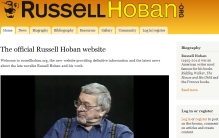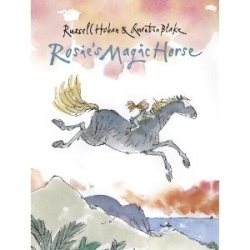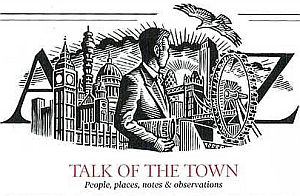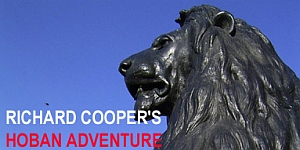The idea for a journey around Russell Hoban's London came to me while I was at work about a week beforehand. I’d already booked "SA4QE Day" off because I’d had the idea to hire a glockenspiel and busk it around London whilst selling yellow-paper poems, in an homage to Kleinzeit, but for various logistical and financial reasons (i.e. I am a complete coward) it couldn't be done. I was therefore left with a whole Hoban day off and nowhere to go – or rather everywhere.
Russell Hoban came to London in the late 1960s, attracted by the atmospheres evoked by such writers as MR James and Joseph Conrad. He originally only intended to live in the capital for a year or two, but ended up staying the rest of his life. (He’s still very much with us, but I doubt he’s likely to leave now.) Since arriving he has written with great passion and accuracy about the city in almost all his adult novels, from Turtle Diary to The Medusa Frequency and most recently The Bat Tattoo. The thought struck me that, as a native Londoner and the only declared London resident on The Kraken, the most appropriate thing for me to do this year would be to pay a suitable homage to Hoban’s London in honour of both his and my own love for the city. There was no shortage of locations; perhaps I could choose two or three and have a relaxing day out, returning home in time to do a bit of writing about it and a leisurely dinner with my wife - a truly appropriate way to spend SA4QE day. Then again, would two or three locations be enough? Couldn't I fit in a few more? How many were there, anyway?
Still sitting at my desk at work (I’m nothing if not impetuous), I made a list of as many London locations that feature in Russ’s books as I could think of. Without having access to the books I counted at least a dozen, including London Zoo, from which William G. and Naeara D. of Turtle Diary released their turtles, the bank of the Thames by Putney Bridge where Herman Orff first meets the head of Orpheus in The Medusa Frequency, and of course Fulham, where many characters from several books (including William and Herman), as well as Hoban himself, live. It didn't seem unreasonable to go to all of them, and do a special feature on the whole thing for the site. When I got home I took all the books which I knew contained London references (I should point out that a minority, such as Riddley Walker, exist completely independently of the capital) and started skimming through them to get as full a list as possible.
Several highly satisfactory hours later, I had a list of no fewer than 40 separate locations. I had no idea how many of these I could physically visit in one day, but I reasoned that if the point was to simply pass through and record my presence with a photo and some yellow paper, I could surely do quite a few – especially as I wouldn’t be walking everywhere, but taking the Tube (traditionally the preferred mode of transport of all Hoban characters) wherever possible.
I then sat down with this list and my old, battered London A to Z - printed in 1990, London residents will be amused to learn it shows Battersea Power Station as "The Battersea Theme Park (opening 1991)" - and highlighted on it the various locations and their respective Tube stations. In most of his books, Russ gives directions to London locations which are geographically exact, but in some cases I had to check the exact address of a shop or church with the help of no less appropriate authorities than the Yellow Pages and Google.co.uk.
Having done that, all that remained bar the shouting (as my feet exploded) was the simple matter of putting the locations into some kind of logical order so I wouldn’t be going back and forth across the city and re-treading old ground unnecessarily. I knew already that I should start by Putney Bridge, preferably between six and seven in the morning, since that was the time of day when Herman Orff found the head of Orpheus in the mud, and apart from anything else if I went to that spot much later I might not be able to get down to the actual mud because the tide would have come in. Being a morning person, I had no problem with the early start – on the contrary, I love that early-morning-time before the rest of the world drags itself up and everything becomes boringly normal. In any case, I had no choice; being up at that time was essential if I really was to visit all these locations in one day.
There were any number of possible routes I could follow, but the one I settled on from Putney took me through Fulham, Parsons Green, Hammersmith, South Kensington, Victoria Embankment, the South Bank, Trafalgar Square, Leicester Square, Camden Town, Islington, Tottenham Court Road, Bloomsbury, Covent Garden, Soho and Tower Hill. Some repetition couldn’t be avoided, and some decisions on the ordering of locations were determined less by how close the locations physically were to each other than by how conveniently they were connected by Tube stations. At this point in the scheduling I also dropped half a dozen provisional locations from the list because given the limited time-frame, I could only visit the more essential landmarks.
I then attempted to plot a time-schedule for travelling between and visiting each location, and although I realised that this would probably fall apart sooner rather than later on the day itself it was important to get an idea of whether the whole thing was possible or not. I worked out that if I got to Putney Bridge by oh-seven-hundred hours (military vocabulary seemed essential) I should be able to do the whole thing with an hour for lunch and be finished by eighteen-hundred.
I put the finishing touches to my schedule shortly before leaving for work on Monday morning. It was only then that I realised that I needed to decide on the yellow paper quotes I would drop, and where. The obvious idea was to find an appropriate quotation for each location, which on the face of it didn’t seem too difficult because it was the mentioning of the locations in the books which had inspired the whole journey, and I’d already marked most of the mentions in the books themselves for easy reference later. However, going through all the novels to find the quotes, as well as typing them out (like Dave Awl, my handwriting is worse than the average doctor’s) quickly became daunting, especially as I had a full day’s work to do on Monday and couldn’t do it at home because my printer was knackered. I reasoned the best thing to do would be to take the books with me to the office and work it all out there during a convenient break. In the end I not only didn’t have time to type up my quotes, but having written about ninety-four summaries of articles about pensions I simply couldn’t face any more typing anyway. Hang on, I reminded myself; I work for a press-cuttings agency, where newspapers and magazine articles are cut out and mounted on a 24-hour basis. All the equipment was there. I photocopied the actual quotes straight from the books, cut them out neatly, glued them to sheets of paper, and then photocopied those onto sheets of yellow paper. (I should add for the purposes of copyright that these copies were the only ones made, and expressly for the purposes of this feature.) While I was doing all this my Hoban-free colleague Rob asked what I was doing. I showed him my planned schedule and told him what it was all about. “You’ll probably think I’m crazy,” I said, “and I probably won’t manage to complete the whole thing, but it’s a nice idea and I’m very excited about it.” He nodded approvingly at the list of landmarks and said, “Actually, it sounds like a really interesting thing to do on your day off.”
I lugged the whole lot home, ate my dinner, and with half an eye on Martin Bashir’s very strange interview with Michael Jackson on ITV, I sorted the quotes into the same order as the locations on my schedule so I wouldn’t have to rummage around on the day itself. The mixture of typefaces as I went through the pages looked interesting and mysterious, like a ransom letter in slow motion. I’d found about thirty location-specific quotes, and maybe another dozen with general references to London which I planned to distribute randomly. On the bottom right hand corner of each sheet I wrote simply the SA4QE acronym; I didn’t have time to write out the whole internet address, and I thought it would make the finding of the quotes more interesting in any case; all anybody had to do to find out what it was all about was enter “SA4QE” into any decent internet search engine and they’d be directed straight to the site.
By the time I’d finished sorting everything out, and - having exchanged incredulous sentiments about the Michael Jackson programme - my wife and I had gone to bed, it was gone eleven. I’d set my alarm for 5.30 and was worried I wouldn’t get enough sleep, or that I’d sleep through the alarm, or ignore it and turn over, in any case getting angry with myself for ruining the whole day. In the event, it was very much like Christmas Eve; my mind was still racing when my head hit the pillow, and I had a sleepless period of an hour or so because of the excitement of it all. In the end the alarm went off and I got up immediately, wide awake and ready to go. I had some cereal, tea and toast, checked my email and posted my birthday greeting to the Kraken – a cheeky list of anagrams of "Russell Hoban" that produced such gems as “Ron Sable-Lush” and “Rosa Bushnell”.
I dressed warmly and packed a rucksack with sandwiches, a bottle of water, a bottle of orange juice, Russ’s birthday bottle of wine on behalf of the Kraken which I was to drop off at his house, a couple of Geobars, a Chunky Kit-Kat, a packet of Hula-Hoops, spare socks, our digital camera inside its makeshift case of a sock (we never seem to get around to buying a proper one), an umbrella, and of course the yellow paper quotes themselves. I’d made a tape the previous evening from a Thelonious Monk CD called Monk’s Mood which was related to a particular location and Hoban reference, but suddenly realised my walkman didn’t work. I had another one, although it was a recording walkman and a bit chunkier, but I took it anyway, together with a blank cassette, reasoning it would be handy for making notes which I wouldn't then have to attempt to decipher. I already had my regular notebook in my overcoat pocket - a Roaring Spring® 3½ x 5¼ 50-sheet stiff-backed Mini Legal Pad, which my friend and fellow Hoban fan Elizabeth had given me for Christmas to bring me luck with my writing. The tiny pad had caught her attention because the paper was yellow, but she’d also realised as she was wrapping it that Roaring Spring was based in Pennsylvania, the same state that Russ comes from, so it was clearly made for today’s job.
I had a dilemma about which shoes to wear. Obviously I needed a good pair for walking all day, but I couldn’t decide between a pair of old boots, which would be very comfortable, sturdy and waterproof but looked very scruffy, or a pair of shoes with Doctor Marten soles which would look more respectable but wouldn’t be quite as tough as the old boots. In the end I decided on the shoes, since there were two essential pubs on my list, both of which had been well-documented by Russ as having signs outside saying PERSONS WITH DIRTY CLOTHES, BOOTS OR SHOES WILL NOT BE SERVED HERE, and I had a Dickensian mental image of an irate landlord hauling me off the premises by my ear and the whole odyssey ruined. Of course, I was overreacting; those notices were really no more than a relic from a bygone age, and anyway my boots weren’t dirty, they were just a bit worn out. In reality, I realised as I tied and double-tied my shoelaces, the landlord fear had been a way of convincing myself that it was OK to choose “smart” over “practical”.
I kissed my wife goodbye and went out into the street. It was just gone six-thirty; I’d been worried as I checked my email that I’d miss my dawn rendezvous with the low-tude mud, but it was still dark and beautifully quiet. I hadn’t been out at that time in the morning for years; although I usually get up at seven every working day, I don’t start work up in central London until midday, so I rarely have any reason or motivation to be outdoors before eleven, let alone dawn. I’d forgotten how peaceful and special it was. The early-morning black of the sky is different from the late-night black, and not just because it’s ever-so-slowly changing to blue; the air smells different, the houses and buildings stand differently, streetlamps and lights in windows shine differently. Walking over Richmond Bridge and down Richmond high street, the only traffic was formed of Royal Mail vans trundling about in pairs, their redness radiating the reassurance of a social infrastructure without the chaos that would soon descend on the city in the form of gridlock.
At the station I bought a peak-time Travelcard which would allow me unlimited use of all trains, Tubes and buses within Central and much of Greater London for the whole day. Given how much use I was planning to make of it, at £7 it felt like a bargain, especially considering that the minimum price of a single bus journey is 70p and a single Tube journey twice that. The Travelcard itself has been around for years, and after 9.30am is even more of a steal at £4.50, but the peak-time version is only a recent innovation, and not before time if you ask me. Until it was invented, day-trippers like me heading out before 9.30am would have to buy a ticket to a particular destination via a specific mode of transport, which had always seemed to me criminally restrictive.
At 6.45 I boarded the first Tube of the day, from Richmond to Putney Bridge via Earls Court. The yellow and orange of the carriage décor was intensified by the still-dark sky. The gently-simmering silence of the train as it waited to leave the station was broken only by the regular coughing of a thin man opposite me reading the sports pages of The Sun. A lean-faced young guy with a shaved head and a toolbox at his feet and nothing to read looked over at him from time to time; the older man’s coughing seemed automatic, like a machine, so much so that the cougher himself had long since stopped noticing his clockwork expectorations. Above the head of the toolbox man, between the adverts for travel insurance and car insurance, was one of the Poems on the Tube, this one by Rafael Alberti:
The waves, blue walls
of Africa, go and come back.
When they go...
Ah, to go with them!
Ah, to come back with them!
When they come back...
...which seemed a good omen for the journey ahead.
* * * *
Further reading: Richard's 28-page report of the journey, complete with photos of each location, the quotes he chose and a personal commentary, is posted on this site in the format of one post per location. Start at the first stop in Putney and work your way across London by clicking on 'next stop' at the bottom of each post.
Even further reading: Richard's adventure was mentioned in a feature about SA4QE in The Independent on Sunday in February 2004. Read the article
Disclaimer: The list of landmarks from Russell Hoban's London visited in this feature was not meant to be exhaustive. This was a one-day attempt at the Riddley Walking Challenge Cup, and as explained above, some locations were decided upon (or against) by the logistics of getting from “A to B” within a reasonable amount of time and without too many flashes of pain in between...







 On 4 February 2012 the Slickman A4 Quotation Event celebrated
On 4 February 2012 the Slickman A4 Quotation Event celebrated 


 In 2005 the first international convention for Russell Hoban fans took place in London, and was marked by the publication of a fantastic 48-page booklet featuring exclusive contributions from innumerable fans and associates including novelist David Mitchell and actress Glenda Jackson. A wonderful memento of the event, it's also a beautiful collector's item and must-have for any Hoban fan. Although in limited supply, copies of the booklet are still available at £6.00 each plus p&p. Order direct from
In 2005 the first international convention for Russell Hoban fans took place in London, and was marked by the publication of a fantastic 48-page booklet featuring exclusive contributions from innumerable fans and associates including novelist David Mitchell and actress Glenda Jackson. A wonderful memento of the event, it's also a beautiful collector's item and must-have for any Hoban fan. Although in limited supply, copies of the booklet are still available at £6.00 each plus p&p. Order direct from  Russell Hoban turned 86 on 4 February 2011 and fans celebrated in traditional style by leaving quotes from his books in public places. Browse their quotes
Russell Hoban turned 86 on 4 February 2011 and fans celebrated in traditional style by leaving quotes from his books in public places. Browse their quotes  To celebrate 30 years in print of Russell Hoban's most famous novel
To celebrate 30 years in print of Russell Hoban's most famous novel 






No comments:
Post a Comment
Note: only a member of this blog may post a comment.